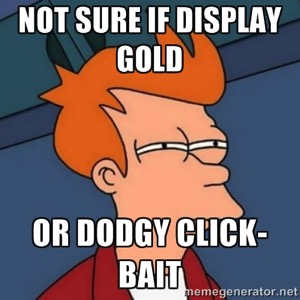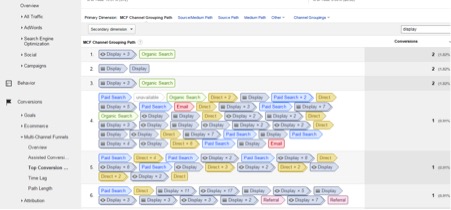Looking at your Display Network automatic placements history can be scary. We all “clean it up” once in a while by:
- Making exclusions
- Updating negative lists
- Changing bids
- Moving converting placements to managed
But what happens when you don’t seem to see anything but a waste of money? Trying to justify that spend with saying “it builds brand and awareness” only gets you so far.
A mixed strategy of in-depth cleaning and optimization, sustained by a reliable attribution model could actually turn this frog into a prince. You can show the value of your work much clearer for all your clients.
1) Click Fraud
Lately some of my Display campaigns seemed to go completely off the rails so I decided to dig deeper. A good place to start is AdWords “invalid clicks” and “invalid click rate” columns. One of the campaigns had an Invalid click rate well over half the clicks it received.

Needless to say bounce rate was also sky high. Luckily, Google is good at spotting these kinds of discrepancies and you can check your billing section for all the invalid click activity credited back to your account.
2) Clickbait Or Relevant AdSense Placement? Depends Who You Ask
Humans and bots think differently, and blackhat SEO is not the only practice where people try to fool bots in the interest of getting ahead.

AdSense works in its own way to match your targeting to placements from the GDN. Certain websites can be designed in the intention of fooling the bot into thinking it provides great placements when it’s actually nothing more than an online “invalid click generator”. This practice impacts industries where CPCs are highly competitive like insurance, forex trading, lawyers etc.
How does this deception work and how can you spot it?
I started from the bottom looking over the placements. Soon I started discovering patterns and filtered the placements accordingly. Some things to look for include:
- High CTR – Yes high CTR, which is usually a reason to celebrate, could actually be a sign of foul play. We all know the Display Network does not usually produce high CTRs, especially on automatic placements. When you see something over 10% you should take a close look. Remember also that you must take into account the number of impressions. A placement with 2 impressions and 50% CTR does not necessarily fit in this category.
- Domain name and content– Even people trying to fool bots run out of ideas. Noticing a pattern in the domain name, you should try to look at these websites side by side and compare features like look and feel, content, logos and structure as you might have stumbled across a scheme intended to steal some of your clicks and budget. I will explain in further detail below.
- Check the other ads on the website – If the website is built to ride on the back of PPC marketing of certain industries, your competitors (or similar market segments) banners are also there most of the time.
3) Bot Food And Real Traffic – A Lethal Mix
Besides bots that are designed to click ads, which are easily spotted by Google or can be dug out by CTR filtering, there are websites that actually attract real traffic to what you could call nonsensical content. One of the recent click-bait schemes I came across involved a whole network of websites containing duplicate content and keywords relevant to my campaigns. The content was wrapped around “viral” videos and posts about a totally different topic (ie. You will not believe how this Big Mac looks after 2 months) and linked to a Facebook page promoting such content. This self-propelled machiavellian mechanism can quickly deplete your campaigns budget. A careful inspection can help you detect if anything like this is impacting your Display performance.
4) Attribution Modeling Has Your Back Covered
If this spring clean-up of your Display campaigns hasn’t brought any major change in costs (or even if it did) – you should always try to find a way to give your campaigns the data-backed credit they deserve.
Analytics has evolved quite a bit and one of my favorite features to help with my attribution is now Top conversion paths under Multi-Channel Funnels. This report gives you the data you need to build a scalable attribution model even if you don’t have access to the more complex attribution tools.

It can look scary at first but playing with Custom channel groupings and with a bit of help from Excel you could actually do wonders for attributing value to your Display efforts.
You can also find a more simplistic version of the tool in the AdWords interface.
Followed on a regular basis, these tips could help you revive and give recognition to this ever-controversial advertising channel.




